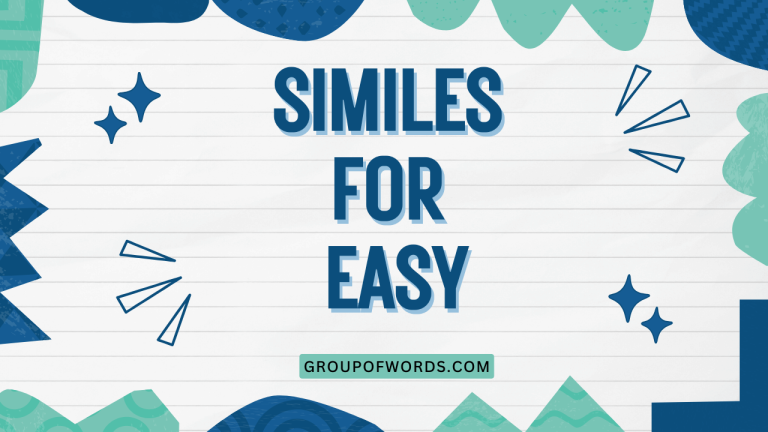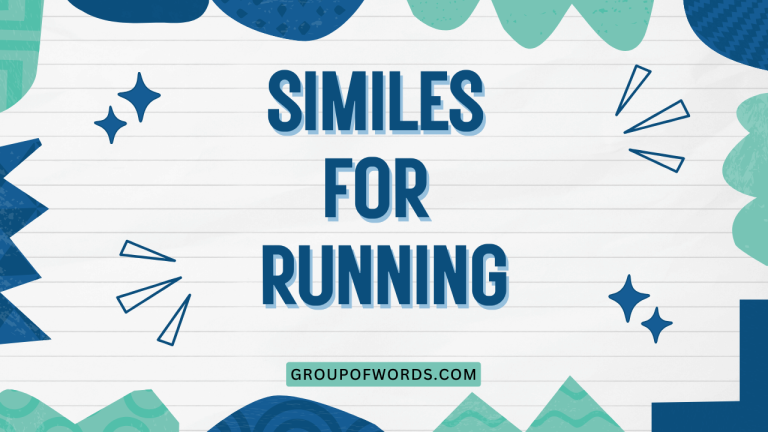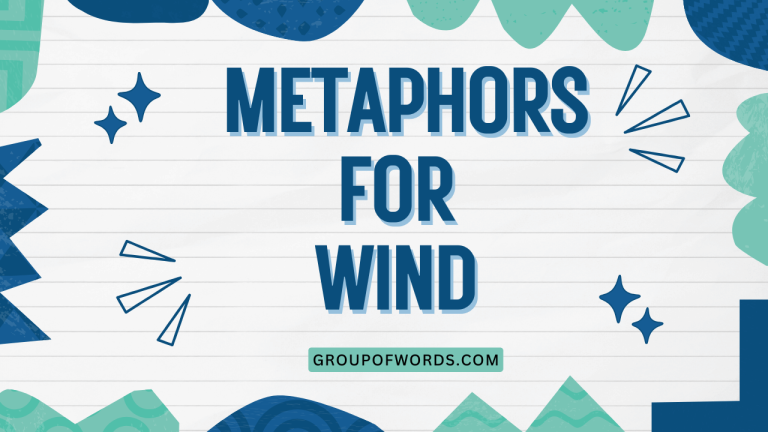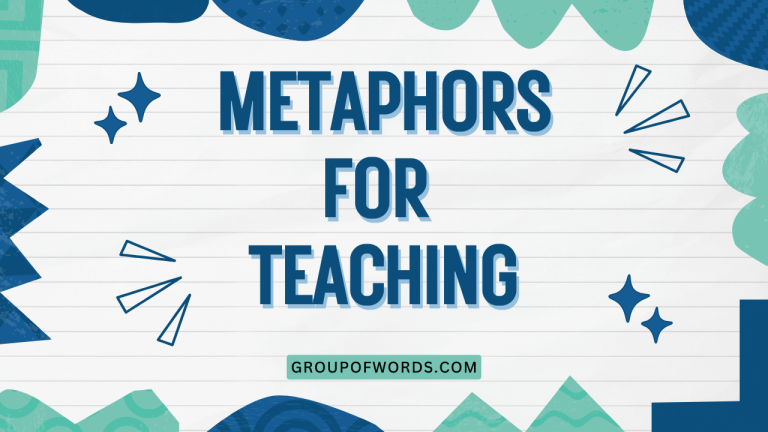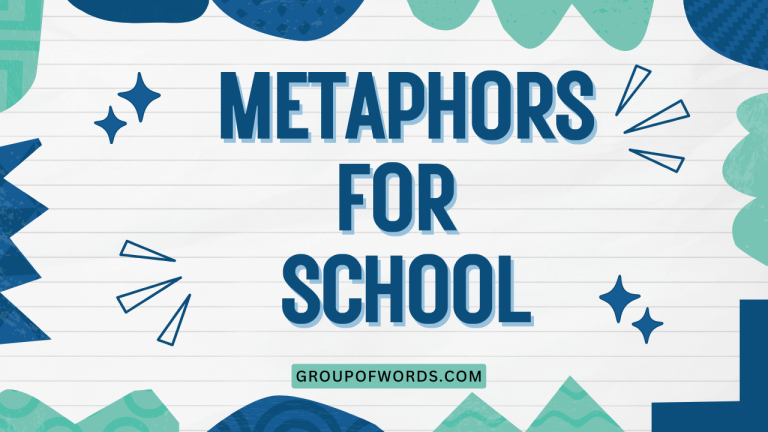Metaphors for Myself: Exploring Self-Perception in Language
Metaphors are powerful tools that allow us to understand abstract concepts by relating them to something more concrete. When we use metaphors to describe ourselves, we gain a deeper insight into our self-perception, values, and aspirations.
Understanding these metaphors is crucial for self-awareness and effective communication. This article explores the various ways we use metaphors to represent ourselves, providing a comprehensive guide for English language learners and anyone interested in exploring their inner world through language.
This article is designed for English language learners of all levels, from intermediate to advanced, as well as anyone interested in self-reflection and the power of language. By the end of this article, you will have a solid understanding of how metaphors work, how they are used to describe oneself, and how to analyze and interpret these metaphors for personal growth.
Table of Contents
- Introduction
- Definition of Metaphor
- Structural Breakdown of Metaphor
- Types of Metaphors for Yourself
- Examples of Metaphors for Yourself
- Usage Rules for Metaphors
- Common Mistakes with Metaphors
- Practice Exercises
- Advanced Topics in Metaphor
- Frequently Asked Questions (FAQ)
- Conclusion
Definition of Metaphor
What is a Metaphor?
A metaphor is a figure of speech that directly compares two unrelated things without using “like” or “as.” It asserts that one thing is another, creating an implicit comparison. Metaphors are used to add color, depth, and understanding to language by transferring qualities from one concept to another. Unlike similes, which explicitly state a comparison, metaphors imply the comparison, making them more impactful and thought-provoking.
For example, saying “He is a lion” is a metaphor, suggesting he possesses lion-like qualities such as strength, courage, or dominance. This is different from a simile, which would be “He is like a lion.” Metaphors are pervasive in everyday language and literature, enriching our communication and allowing us to express complex ideas in a concise and vivid manner.
Function of Metaphor
The primary function of a metaphor is to provide a new perspective on a subject by associating it with something familiar or easily understood. Metaphors can clarify abstract concepts, evoke emotions, and create vivid imagery.
They also add layers of meaning to language, allowing for multiple interpretations and deeper engagement with the text or conversation.
Metaphors are instrumental in understanding complex ideas by linking them to simpler, more relatable concepts. For instance, describing life as “a rollercoaster” helps convey the ups and downs, excitement, and unpredictability of life in a way that is easily grasped.
In essence, metaphors serve as bridges between the known and the unknown, making abstract ideas more tangible and comprehensible.
Context of Metaphor
The effectiveness of a metaphor heavily relies on its context. The cultural background, personal experiences, and shared knowledge between the speaker and the audience all influence how a metaphor is understood and interpreted.
A metaphor that resonates in one context may be confusing or even offensive in another.
Consider the metaphor “She is a diamond.” In a Western context, this might suggest she is valuable, beautiful, and resilient. However, in a different culture where diamonds have a different symbolic meaning, the metaphor might be interpreted differently.
Therefore, understanding the context in which a metaphor is used is crucial for accurate interpretation and effective communication. The specific situation, the relationship between the speaker and listener, and the overall tone of the conversation all contribute to the meaning and impact of the metaphor.
Structural Breakdown of Metaphor
Tenor and Vehicle
I. A. Richards, a renowned literary critic, introduced the terms tenor and vehicle to describe the two essential components of a metaphor. The tenor is the subject being described, while the vehicle is the object or concept used to describe it. The vehicle carries the metaphorical meaning and transfers its qualities to the tenor.
For example, in the metaphor “He is a rock,” “he” is the tenor (the subject being described), and “rock” is the vehicle (the object providing the metaphorical meaning). The qualities associated with a rock, such as strength, stability, and resilience, are transferred to “he,” suggesting that he possesses these characteristics.
Understanding the tenor and vehicle helps to dissect and interpret the meaning of a metaphor effectively.
Ground
The ground refers to the shared characteristics or similarities between the tenor and the vehicle. It’s the basis upon which the comparison is made. Identifying the ground is crucial for understanding why a particular vehicle was chosen to represent the tenor.
In the metaphor “My heart is a lonely hunter,” the ground lies in the shared characteristic of being solitary and searching. The heart (tenor) is compared to a lonely hunter (vehicle) because both are perceived as being alone and constantly seeking something.
Recognizing the ground allows us to appreciate the depth and nuance of the metaphor, as it reveals the specific qualities being emphasized in the comparison. The ground provides the logical connection that makes the metaphor meaningful and understandable.
Types of Metaphors for Yourself
Nature Metaphors
Nature metaphors use elements of the natural world to describe aspects of oneself. These metaphors often reflect qualities such as growth, resilience, beauty, or the ability to adapt to changing environments.
Common nature metaphors involve comparisons to trees, flowers, rivers, and mountains.
For instance, describing oneself as “a sturdy oak” suggests strength, longevity, and the ability to withstand challenges. Alternatively, being “a flowing river” might indicate adaptability, constant movement, and a journey through life.
Nature metaphors provide a rich and evocative way to express personal characteristics and experiences, drawing upon the inherent symbolism associated with different elements of the natural world. The use of nature metaphors can also highlight a connection to the environment and a sense of being part of a larger ecosystem.
Object Metaphors
Object metaphors use inanimate objects to represent aspects of one’s personality, skills, or experiences. These metaphors often highlight qualities such as functionality, durability, or aesthetic appeal.
Common object metaphors include comparisons to tools, machines, and structures.
For example, describing oneself as “a well-oiled machine” suggests efficiency, precision, and the ability to perform tasks smoothly. Being “a sturdy bridge” might indicate the ability to connect people and facilitate understanding.
Object metaphors provide a practical and tangible way to express personal attributes, emphasizing the functional and structural aspects of one’s character. The choice of object can also reflect specific skills or areas of expertise, such as being “a sharp knife” to indicate precision and effectiveness.
Animal Metaphors
Animal metaphors use animals to represent aspects of one’s character, behavior, or instincts. These metaphors often draw upon the symbolic associations commonly attributed to different animals.
Common animal metaphors include comparisons to lions, wolves, doves, and foxes.
For instance, describing oneself as “a fierce lion” suggests courage, dominance, and leadership qualities. Alternatively, being “a gentle dove” might indicate peace, tranquility, and compassion.
Animal metaphors provide a powerful and evocative way to express personal traits, tapping into the inherent symbolism associated with different species. The choice of animal can also reflect specific behaviors or instincts, such as being “a cunning fox” to indicate intelligence and strategic thinking.
These metaphors often carry strong emotional connotations, making them particularly impactful in communication.
Journey Metaphors
Journey metaphors use the concept of a journey to represent one’s life, experiences, or personal growth. These metaphors often highlight the challenges, obstacles, and milestones encountered along the way.
Common journey metaphors include comparisons to roads, paths, and voyages.
For example, describing one’s life as “a winding road” suggests that there have been many twists, turns, and unexpected events. Alternatively, being “a long voyage” might indicate a significant period of exploration, discovery, and personal transformation.
Journey metaphors provide a meaningful and relatable way to express the passage of time and the accumulation of experiences, emphasizing the dynamic and evolving nature of life. These metaphors can also highlight the importance of perseverance, resilience, and the pursuit of personal goals.
The use of journey metaphors often implies a sense of purpose and direction, even in the face of uncertainty.
Building Metaphors
Building metaphors use structures and construction to represent aspects of one’s personality, achievements, or relationships. These metaphors often highlight qualities such as strength, stability, and the ability to create and maintain something lasting.
Common building metaphors include comparisons to houses, castles, and skyscrapers.
For instance, describing oneself as “a solid foundation” suggests reliability, stability, and the ability to support others. Alternatively, being “a towering skyscraper” might indicate ambition, achievement, and the ability to reach great heights.
Building metaphors provide a tangible and structural way to express personal attributes, emphasizing the importance of planning, effort, and perseverance. The choice of building can also reflect specific values or aspirations, such as being “a welcoming home” to indicate warmth, hospitality, and a sense of belonging.
These metaphors often imply a sense of permanence and legacy, suggesting that one’s actions and contributions will have a lasting impact.
Examples of Metaphors for Yourself
The following tables provide extensive examples of metaphors used to describe oneself, categorized by type. Each table includes a variety of examples to illustrate the different ways these metaphors can be used.
Nature Metaphors Examples
This table provides examples of nature metaphors used to describe oneself, including the metaphor, the implied meaning, and the quality being emphasized.
| Metaphor | Implied Meaning | Quality Emphasized |
|---|---|---|
| I am a sturdy oak. | I am strong and resilient. | Strength, Resilience |
| I am a flowing river. | I am adaptable and ever-changing. | Adaptability, Change |
| I am a blooming flower. | I am beautiful and growing. | Beauty, Growth |
| I am a towering mountain. | I am steadfast and enduring. | Steadfastness, Endurance |
| I am a gentle breeze. | I am calming and refreshing. | Calmness, Refreshment |
| I am a deep ocean. | I am full of mysteries and depth. | Mystery, Depth |
| I am a bright sun. | I am illuminating and warm. | Illumination, Warmth |
| I am a quiet forest. | I am peaceful and serene. | Peace, Serenity |
| I am a wild storm. | I am passionate and intense. | Passion, Intensity |
| I am a fertile field. | I am productive and nurturing. | Productivity, Nurturing |
| I am a budding tree. | I am full of potential. | Potential |
| I am a vast desert. | I am barren but full of hidden beauty. | Hidden beauty, Resilience |
| I am a roaring waterfall. | I am powerful and unstoppable. | Power, Unstoppability |
| I am a whispering wind. | I am subtle and insightful. | Subtlety, Insightfulness |
| I am a lush garden. | I am diverse and vibrant. | Diversity, Vibrancy |
| I am a silent star. | I am guiding and constant. | Guidance, Constancy |
| I am a clear sky. | I am open and honest. | Openness, Honesty |
| I am a winding river. | I am flowing and adaptable. | Adaptability, Flow |
| I am a blooming rose. | I am beautiful and delicate. | Beauty, Delicacy |
| I am a strong root. | I am grounded and supportive. | Groundedness, Support |
| I am a dense forest. | I am complex and mysterious. | Complexity, Mystery |
| I am a bright rainbow. | I am hopeful and promising. | Hope, Promise |
| I am a tall grass. | I am resilient and flexible. | Resilience, Flexibility |
| I am a green leaf. | I am growing and vibrant. | Growth, Vibrancy |
Object Metaphors Examples
This table provides examples of object metaphors used to describe oneself, including the metaphor, the implied meaning, and the quality being emphasized.
| Metaphor | Implied Meaning | Quality Emphasized |
|---|---|---|
| I am a well-oiled machine. | I am efficient and precise. | Efficiency, Precision |
| I am a sturdy bridge. | I connect people and ideas. | Connection, Understanding |
| I am a sharp knife. | I am incisive and effective. | Incisiveness, Effectiveness |
| I am a blank canvas. | I am full of potential for creation. | Potential, Creativity |
| I am a guiding compass. | I provide direction and clarity. | Direction, Clarity |
| I am a strong anchor. | I am reliable and grounding. | Reliability, Grounding |
| I am a bright lightbulb. | I generate ideas and inspiration. | Inspiration, Innovation |
| I am a complex puzzle. | I am intricate and challenging. | Intricacy, Challenge |
| I am a sturdy shield. | I am protective and resilient. | Protection, Resilience |
| I am a fine-tuned instrument. | I am skilled and precise. | Skill, Precision |
| I am a sturdy book. | I am full of knowledge and wisdom. | Knowledge, Wisdom |
| I am a reliable clock. | I am punctual and consistent. | Punctuality, Consistency |
| I am a strong magnet. | I attract opportunities and people. | Attraction, Influence |
| I am a polished mirror. | I reflect truth and clarity. | Truth, Clarity |
| I am a delicate vase. | I am precious and require care. | Preciousness, Care |
| I am a solid lock. | I am secure and trustworthy. | Security, Trustworthiness |
| I am a warm blanket. | I provide comfort and security. | Comfort, Security |
| I am a sharp pencil. | I am precise and articulate. | Precision, Articulation |
| I am a sturdy table. | I am supportive and reliable. | Support, Reliability |
| I am a bright candle. | I provide light and warmth. | Light, Warmth |
| I am a strong rope. | I connect and bind people. | Connection, Binding |
| I am a clear lens. | I provide clarity and focus. | Clarity, Focus |
| I am a durable tire. | I am resilient and enduring. | Resilience, Endurance |
| I am a fast computer. | I am efficient and quick. | Efficiency, Quickness |
Animal Metaphors Examples
This table provides examples of animal metaphors used to describe oneself, including the metaphor, the implied meaning, and the quality being emphasized.
| Metaphor | Implied Meaning | Quality Emphasized |
|---|---|---|
| I am a fierce lion. | I am courageous and dominant. | Courage, Dominance |
| I am a gentle dove. | I am peaceful and compassionate. | Peace, Compassion |
| I am a cunning fox. | I am intelligent and strategic. | Intelligence, Strategy |
| I am a busy bee. | I am productive and diligent. | Productivity, Diligence |
| I am a graceful swan. | I am elegant and poised. | Elegance, Poise |
| I am a loyal dog. | I am faithful and devoted. | Faithfulness, Devotion |
| I am a wise owl. | I am knowledgeable and perceptive. | Knowledge, Perception |
| I am a playful dolphin. | I am joyful and intelligent. | Joy, Intelligence |
| I am a strong bear. | I am powerful and protective. | Power, Protection |
| I am a nimble cat. | I am agile and independent. | Agility, Independence |
| I am a fast cheetah. | I am quick and efficient. | Quickness, Efficiency |
| I am a patient turtle. | I am persistent and calm. | Persistence, Calmness |
| I am a soaring eagle. | I am ambitious and visionary. | Ambition, Vision |
| I am a social wolf. | I am loyal and collaborative. | Loyalty, Collaboration |
| I am a colorful parrot. | I am expressive and communicative. | Expressiveness, Communication |
| I am a quiet mouse. | I am observant and discreet. | Observance, Discretion |
| I am a hard-working ant. | I am diligent and organized. | Diligence, Organization |
| I am a graceful deer. | I am gentle and agile. | Gentleness, Agility |
| I am a strong horse. | I am powerful and reliable. | Power, Reliability |
| I am a clever monkey. | I am intelligent and adaptable. | Intelligence, Adaptability |
| I am a vibrant butterfly. | I am transformative and beautiful. | Transformation, Beauty |
| I am a resilient spider. | I am persistent and creative. | Persistence, Creativity |
| I am a calm heron. | I am patient and observant. | Patience, Observance |
| I am a brave tiger. | I am courageous and strong. | Courage, Strength |
Journey Metaphors Examples
This table provides examples of journey metaphors used to describe oneself, including the metaphor, the implied meaning, and the quality being emphasized.
| Metaphor | Implied Meaning | Quality Emphasized |
|---|---|---|
| I am a winding road. | My life has had many twists and turns. | Adaptability, Resilience |
| I am a long voyage. | I have experienced significant exploration and growth. | Exploration, Growth |
| I am a challenging climb. | I have overcome many obstacles. | Perseverance, Strength |
| I am a smooth path. | My life has been relatively easy. | Ease, Fortune |
| I am a scenic route. | My life has been full of beauty and wonder. | Beauty, Wonder |
| I am a difficult trek. | I have faced many hardships. | Endurance, Determination |
| I am a winding river delta. | My life has branched out in many directions. | Versatility, Diversity |
| I am a never-ending quest. | I am always seeking knowledge and understanding. | Curiosity, Knowledge |
| I am a pilgrimage. | My life has a spiritual purpose. | Spirituality, Purpose |
| I am a race against time. | I feel pressured to achieve my goals quickly. | Urgency, Ambition |
| I am a treasure hunt. | I am always searching for something valuable. | Search, Value |
| I am a cross-country run. | I am enduring and determined. | Endurance, Determination |
| I am a journey of self-discovery. | I am learning more about myself. | Self-awareness, Discovery |
| I am a spiritual retreat. | I am seeking inner peace and reflection. | Peace, Reflection |
| I am a path less traveled. | I am unique and unconventional. | Uniqueness, Individuality |
| I am a road to success. | I am working towards achieving my goals. | Success, Achievement |
| I am a cycle of seasons. | I am experiencing constant change and renewal. | Change, Renewal |
| I am a path through the woods. | I am navigating through complexity and uncertainty. | Complexity, Uncertainty |
| I am a journey to the stars. | I am reaching for ambitious goals. | Ambition, Aspiration |
| I am a quest for meaning. | I am searching for purpose in life. | Purpose, Meaning |
| I am a voyage of exploration. | I am discovering new things and experiences. | Discovery, Experience |
| I am a path of enlightenment. | I am seeking wisdom and understanding. | Wisdom, Understanding |
| I am a road of trials. | I am facing challenges and tests. | Challenge, Testing |
| I am a journey home. | I am seeking comfort and belonging. | Comfort, Belonging |
Building Metaphors Examples
This table provides examples of building metaphors used to describe oneself, including the metaphor, the implied meaning, and the quality being emphasized.
| Metaphor | Implied Meaning | Quality Emphasized |
|---|---|---|
| I am a solid foundation. | I am reliable and supportive. | Reliability, Support |
| I am a towering skyscraper. | I am ambitious and successful. | Ambition, Success |
| I am a welcoming home. | I am warm and hospitable. | Warmth, Hospitality |
| I am a sturdy fortress. | I am resilient and protective. | Resilience, Protection |
| I am a well-designed structure. | I am organized and efficient. | Organization, Efficiency |
| I am a bridge to the future. | I connect the present to what’s ahead. | Connection, Vision |
| I am a lighthouse. | I guide and provide direction. | Guidance, Direction |
| I am a construction site. | I am a work in progress. | Progress, Development |
| I am a carefully planned city. | I am organized and strategic. | Organization, Strategy |
| I am a renovated building. | I have undergone significant transformation. | Transformation, Renewal |
| I am a strong wall. | I am protective and resilient. | Protection, Resilience |
| I am a stable platform. | I am supportive and reliable. | Support, Reliability |
| I am a well-lit room. | I am clear and insightful. | Clarity, Insight |
| I am a solid base. | I am grounding and dependable. | Grounding, Dependability |
| I am a flexible structure. | I am adaptable and resilient. | Adaptability, Resilience |
| I am a decorated space. | I am unique and expressive. | Uniqueness, Expression |
| I am a renovated home. | I am improved and renewed. | Improvement, Renewal |
| I am a secure vault. | I am trustworthy and protective. | Trustworthiness, Protection |
| I am a grand palace. | I am impressive and influential. | Impressiveness, Influence |
| I am a simple cabin. | I am humble and content. | Humility, Contentment |
| I am a modern building. | I am innovative and forward-thinking. | Innovation, Forward-thinking |
| I am a historic landmark. | I am significant and memorable. | Significance, Memorability |
| I am a sustainable structure. | I am responsible and enduring. | Responsibility, Endurance |
| I am a complex network. | I am interconnected and resourceful. | Interconnectedness, Resourcefulness |
Usage Rules for Metaphors
Clarity and Relevance
A good metaphor should be clear and relevant to the subject it is describing. Avoid metaphors that are too obscure or complicated, as they may confuse the audience.
Ensure that the comparison makes sense and enhances understanding, rather than hindering it. The metaphor should illuminate the subject in a new and insightful way.
For example, instead of saying “I am a quantum entanglement,” which might be confusing to many, a clearer metaphor might be “I am a guiding star,” which conveys a sense of direction and inspiration. The goal is to choose a metaphor that resonates with the audience and effectively communicates the intended meaning.
Consistency in Metaphor
Maintain consistency within a metaphor to avoid creating mixed or contradictory images. If you start with one metaphor, stick with it throughout the description.
Mixing metaphors can lead to confusion and weaken the impact of your message. Choose one metaphor and build upon it to create a cohesive and compelling narrative.
For example, if you describe yourself as “a sturdy oak,” continue with related metaphors such as “my roots run deep” or “I weather the storms.” Avoid mixing it with a different metaphor, such as “I am also a flowing river,” as this can create a disjointed and confusing image. Consistency helps to reinforce the intended message and create a stronger impact.
Cultural Sensitivity
Be mindful of cultural differences and sensitivities when using metaphors. A metaphor that is appropriate in one culture may be offensive or misunderstood in another.
Consider the cultural context and ensure that the metaphor is respectful and inclusive. Avoid using metaphors that perpetuate stereotypes or reinforce harmful biases.
For example, certain animal metaphors may have different connotations in different cultures. A metaphor that is considered positive in one culture may be negative in another.
It’s important to research and understand the cultural implications of your metaphors to avoid unintentional offense or miscommunication. Sensitivity to cultural nuances enhances the effectiveness and appropriateness of your communication.
Common Mistakes with Metaphors
One common mistake is using mixed metaphors, where the comparison becomes illogical or contradictory. For example, saying “I’m climbing the ladder of success, but it’s a slippery slope” combines two conflicting images. A ladder suggests upward progress, while a slippery slope implies a decline. This creates confusion and weakens the intended message. The correct way to phrase this might be either “I’m climbing the ladder of success, but it’s a challenging climb” or “The road to success is a slippery slope, requiring careful navigation.”
Another frequent error is using overused or clichéd metaphors, which lack originality and impact. For instance, saying “Life is a rollercoaster” is a common metaphor, but it has lost its freshness due to overuse. A more original metaphor could be “Life is a complex symphony, with moments of harmony and dissonance,” which offers a more nuanced and evocative description. Strive for creativity and originality in your metaphors to make them more memorable and impactful.
Finally, using metaphors that are too abstract or obscure can hinder understanding. The purpose of a metaphor is to clarify and enhance understanding, not to confuse the audience. Ensure that the comparison is clear and relevant. For example, avoid saying “I am a fractal dimension,” which is too technical and abstract for most people. Instead, opt for a simpler and more relatable metaphor, such as “I am a mosaic of experiences,” which conveys a sense of complexity and diversity in a more accessible way.
| Incorrect | Correct |
|---|---|
| I’m drowning in opportunity. | I’m overwhelmed with opportunity. |
| He’s burning the midnight oil at both ends. | He’s burning the midnight oil. |

